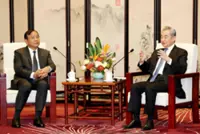Choices aplenty: Cartons of cigarettes are considered appropriate business gifts. — The Straits Times/ANN
Twenty years after adopting the World Health Organisation (WHO) Framework Convention on Tobacco Control (FCTC), China is still addicted to cigarettes.
The world’s largest producer and consumer of tobacco, it has an estimated 300 million smokers, nearly a third of the world’s total.





